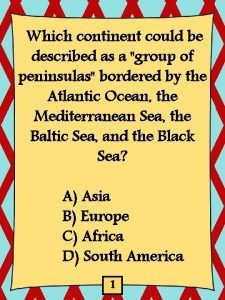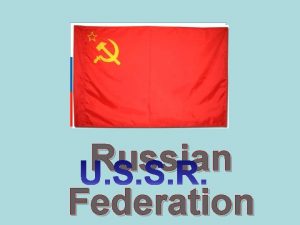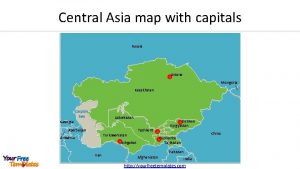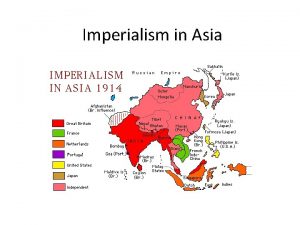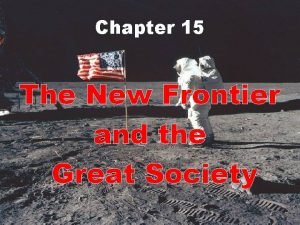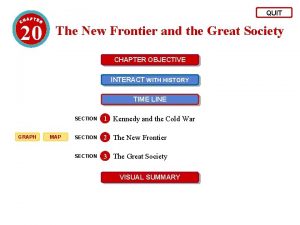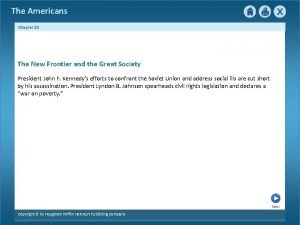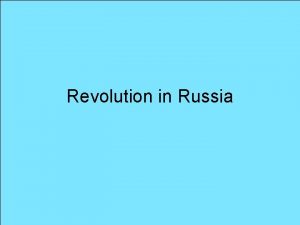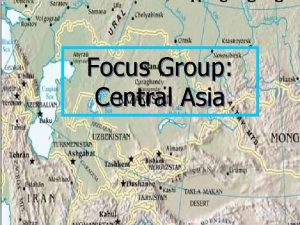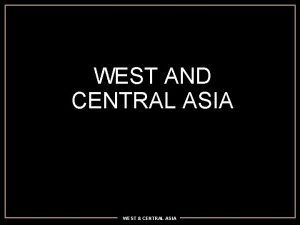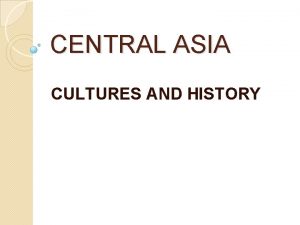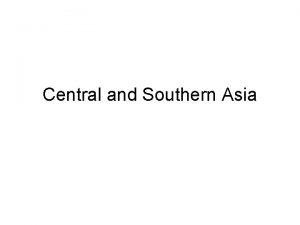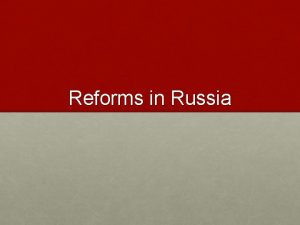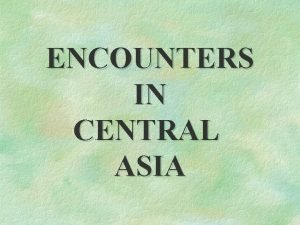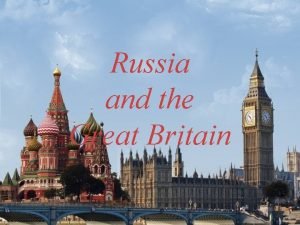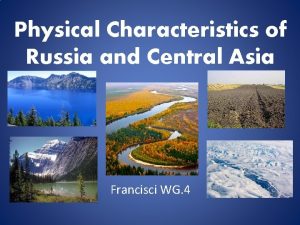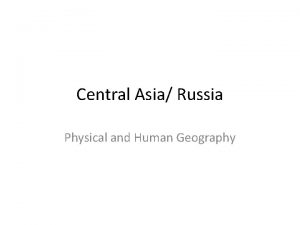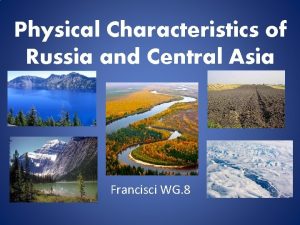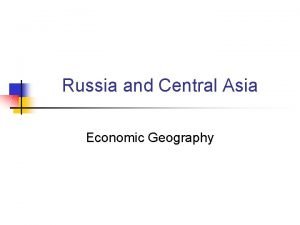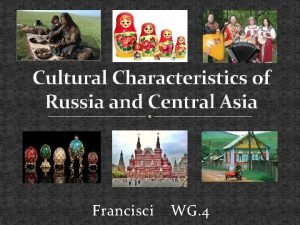Russia and Central Asia Central Asia New Great



















- Slides: 19

Russia and Central Asia

Central Asia

New Great Game Theory • Russia have clear goals and Central Asia and a strategy to maximize its influence in the region; • Main players: Russia, China, Unites States, EU, Iran, Turkey.

Central Asia in the Soviet Union • • • • Mixture of the modernization and backwardness; Central Asia in the Soviet regional specialization; Cotton production; Demographic Explosion; Poverty; Disurbanization of the region; Problems with the security; Low level of education and medical care; Islamic revival; Culturally alien to Russia; Increase of the drug imports; Corruption and shadow economy; Russian minorities in the Central Asian republics.

The Interests of Central Asian Countries in Russia • • Security; Gas and oil transportation; Economic cooperation; Russia as counterbalance to China.

Civil War in Tajikistan (1992– 1997) • People’s Front and Islamic-democratic coalition; • December 4, 1992 – People’s Front captured Dushanbe; • December 1992 – 201 division of the former Soviet Army (actually Russian army) occupied the key points of Dushanbe; • Russian government supported People’s Front and new Tajik government; • May 1992 – Russia, Armenia, Kazakhstan, Kyrgyzstan, Tajikistan, Uzbekistan signed an Agreement about collective security in the CIS (CST or Tashkent Treaty).

Military Cooperation • Russian border troops protected Kyrgyz border with China; • Russian-Turkmen military cooperation and protection of the Turkmen-Afghan border; • Kazakhstan and Budapest Memorandum, 1994

Russian Interests in Central Asia • • Security; Geopolitics; Integration projects; Economy.

The Conceptual Foundations of Russian Policy in Central Asia • Postimperial ideology; • Anti-Westernism; • Eurasian idea.

The Periods of the Russian-Central Asian Relations • 1991– 1995 – Russia neglected and abandoned the Central Asia; • 1996– 1999 – more active Russian policy in Central Asia; bilateral treaties; • 1999– 2001 – the growth of Russian influence in the region; • 2001– 2004 – the growth of American influence in the region. Russia had to develop mutually beneficial relations; • 2004– 2010 – the growth of Russian influence after colored revolutions and Andijan massacre; • 2011– 2015 – Russia’s integration projects;

1991– 1995 Year Volume of trade, millions of US dollars Russian exports to Central Asia, millions of US dollars Russian imports from Central Asia, millions of US dollars 1991 59226 33785 25441 1992 6360 5767 593 1993 6750 4703 2047 1994 6143 3771 2372 1995 7679 4230 3449 Paramonov V. , Strokov A. The Evolution of Russia’s Central Asia Policy // Advanced Research and Assessment Group. Central Asian Series. June 2008

1996 - 1999 • 1995– 1996 – Customs Union (Belarus, Russia, Kazakhstan, Kyrgyzstan); • Kazakhstan and Kyrgyzstan were developing multipolar foreign policy; • 1997 – unstable peace in Tajikistan; • 1998 – Uzbekistan attempted a military coup in Tajikistan; • 1999 – Uzbekistan joined GUAM and refused to prolong Agreement about collective security of the CIS; • Turkmenistan turned to isolationism and military cooperation; • Tajikistan was the only Russian-oriented country; • Russian-American clash of interests in the region;

1999– 2001 • 1998 – Islamic Movement of Uzbekistan was created (IMU); • 1999– 2000 – IMU invaded Kyrgyzstan and organized unsuccessful attempts on Karimov’s life; • 1999 – the second Chechen war began; • October 10, 2000 – Eurasian Economic Community came into existence (Belarus, Russia, Kazakhstan, Kyrgyzstan, Tajikistan); • 2002 – Collective Security Treaty Organization was established (CSTO) and Collective Rapid Response Forces were created.

2001– 2004 • October 7, 2001 – the US started the operation against Taliban; • Kazakhstan, Kyrgyzstan, Uzbekistan, Tajikistan permitted US military bases on their territory; • 2001– 2002 – Central Asian Cooperation Organization (CACO); • Russia made some steps toward Central Asian countries (Russia agreed to discuss the delimitation of the Caspian seabed, rejected the idea of the double citizenship for citizens of Turkmenistan etc. )

2004– 2010 • Colored revolutions and Andijan rebellion; • Russia joined CACO and it merged with Evr. Az. EC; • Russia as an “energy super-power”; • Cheap labor force from Central Asia

Central Asia and Putin’s Integration Project • Eurasian Economic Union – Belarus, Kazakhstan, Russia (January 1, 2015), Armenia (January 2, 2015), Kyrgyzstan (May, 2015)

Central Asian Republics and Ukrainian Crisis

Russian Minorities in Central Asia Country Russian minority Kazakhstan 3 685 009 (21, 47 %) – 2014 Kyrgyzstan 394, 7 (7, 2 %) - 2011 Tajikistan 34 800 (0, 5 %) - 2010 Turkmenistan 180 000 (3, 5 %) - 2005 Uzbekistan 1 199 015 (4, 91 %) - 2000

The Challenges for Russian Influence in the region • • The influence of the great powers, first of all China; Islamic terrorism; Multivector foreign policy of the Central Asian republics; Poor economic performance.
 Which letter represents the danube river
Which letter represents the danube river Russian federation is in which continent
Russian federation is in which continent River in central russia
River in central russia Swana map
Swana map Why is water pollution a great concern in southwest asia
Why is water pollution a great concern in southwest asia Why is water pollution of great concern in southwest asia
Why is water pollution of great concern in southwest asia Astana russia map
Astana russia map Conqueror of central asia
Conqueror of central asia Imperialism asia
Imperialism asia Aaa new deal
Aaa new deal Chapter 15 the new frontier and the great society
Chapter 15 the new frontier and the great society The new frontier and great society
The new frontier and great society Main idea
Main idea The americans chapter 28
The americans chapter 28 Chapter 33 the great depression and the new deal
Chapter 33 the great depression and the new deal New york, new jersey, pennsylvania, and delaware
New york, new jersey, pennsylvania, and delaware Fresh oil new wine
Fresh oil new wine Articles of confederation characteristics
Articles of confederation characteristics Marketing management
Marketing management New classical and new keynesian macroeconomics
New classical and new keynesian macroeconomics
